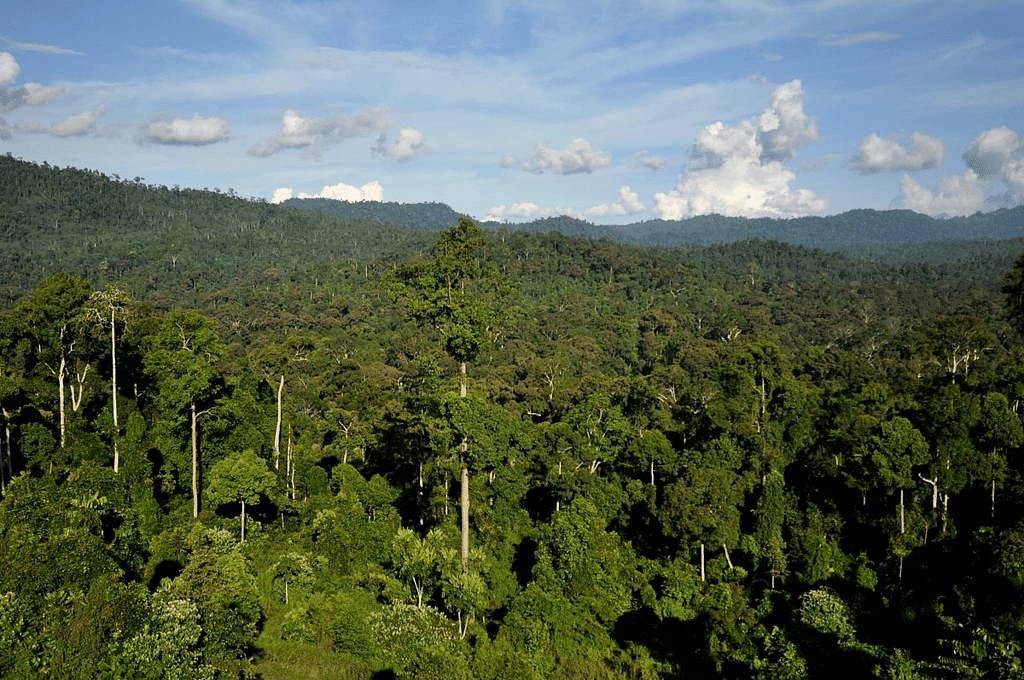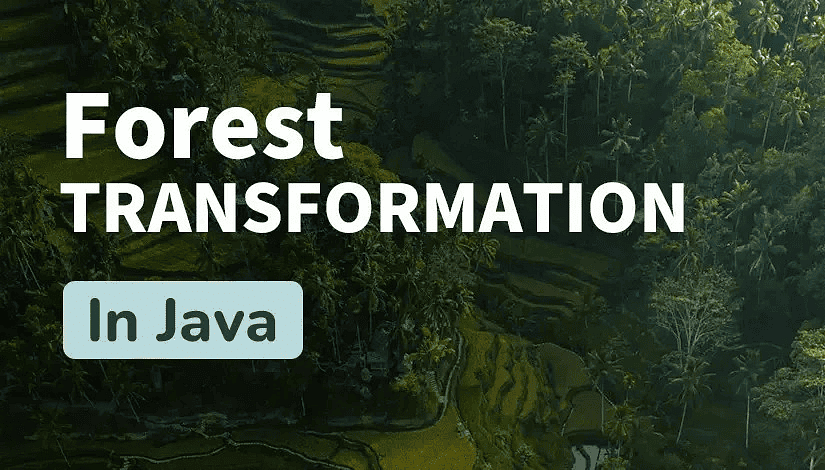Class 9 History Chapter 4 Notes - Forest Society and Colonialism
| Table of contents |

|
| Why Deforestation? |

|
| The Rise of Commercial Forestry |

|
| Rebellion in the Forest |

|
| Forest Transformations in Java |

|
| Difficult Words |

|
Forest play a major role in improving the quality of the environment, modifying the local climate, controlling soil erosion, regulating stream flow, supporting a variety of industries, providing a livelihood for many communities, and after recreation opportunities.
 Forests
Forests
- They also provide a natural environment for wildlife and play an important role in maintaining the life support system.
- Forests have long been an integral part of human life, contributing to various aspects of our daily existence.
- The diversity within forests, such as those in the Amazon or the Western Ghats, is astounding, with some patches hosting hundreds of plant species.
- However, this rich diversity is rapidly diminishing. Between 1700 and 1995, industrialization led to the clearing of 13.9 million square kilometers of forest, representing 9.3% of the world's forested area. Question for Detailed Chapter Notes - Forest Society and ColonialismTry yourself:What is one of the major roles played by forests in the environment?View Solution
Why Deforestation?
The disappearance of forests is called deforestation. Deforestation is not a recent problem. The process began many centuries ago, but it became more systematic and extensive under colonial rule. Deforestation
Deforestation
Land to be Improved
- 1600 Land Use: Approximately one-sixth of India's landmass was under cultivation.
- Current Land Use: Cultivated area have increased to about half of India's landmass.
- Population Growth: Increased population and demand for food led to the expansion of cultivated land.
- Colonial Influence: The British encouraged the production of commercial crops like jute, sugar, wheat, and cotton.
- European Demand: Nineteenth-century Europe needed food grains and raw materials for industrial production.
- Colonial Perspective: Forests were seen as unproductive wilderness, leading to their clearance for agriculture.
- Cultivated Area Increase: Between 1880 and 1920, cultivated land increased by 6.7 million hectares.
- Impact of Expansion: Expansion of cultivation often involved clearing forests, impacting environmental balance.
Sleepers on the Tracks
- Early 19th Century Timber Issue: Disappearance of oak forests in England led to a shortage of timber for the Royal Navy.
- Search for Alternatives: By the 1820s, search parties were sent to India to explore forest resources.
- Timber Export: Massive deforestation in India began, with timber exported to England.
- Railway Expansion (1850s): New demand for timber for railway construction and fuel.
- Railway Sleepers: Each mile of railway track required 1,760 to 2,000 sleepers made from wood.
- Network Growth: By 1890, 25,500 km of railway track; by 1946, over 765,000 km.
- Deforestation Impact: Rapid expansion led to increased felling of trees, notably in the Madras Presidency where 35,000 trees were cut annually for sleepers.
- Indiscriminate Cutting: Contractors, given government contracts, began cutting trees indiscriminately, causing significant forest loss.
Plantations
Large areas of natural forests were also cleared to make way for tea, coffee, and rubber plantations to meet Europe’s growing need for these commodities.
 Plantations
Plantations
- The colonial government took over the forests and gave European planters vast areas cheaply.
- These areas were enclosed, cleared of forests, and planted with tea or coffee.
The Rise of Commercial Forestry
In India, colonial rulers needed huge supplies of wood for railways and ships. This led to widespread deforestation. The British government got alarmed. The government invited Dietrich Brandis, a German forest expert, for advice, and he was appointed the first Inspector General of Forests in India. Brandis emphasises that rules need to be framed about using forest wealth. Brandis realized that a proper system had to be introduced to manage the forests, and people had to be the need for conservation.

This system needed legal sanction. It was at his initiative that;
- Indian Forest Service was set up in 1864.
- Indian Forest Act was enacted in 1865
- Imperial Forest Research Institute was set up in 1906. The system they taught here was called ‘scientific forestry’.
The 1878 Act divided forests into reserved, protected and village forests. The best forests were called ‘reserved forestry’. Villagers could not take anything from these forests, even for their use. They could take wood from protected or village forests for house building or fuel.
How were the Lives of People Affected?
1. Conflicting Views on Forests:
- Villagers: Preferred diverse forests for fuel, fodder, and other needs.
- Forest Department: Desired trees suited for construction, focusing on hardwood species like teak and sal.
2. Uses of Forest Products by Villagers:
- Nutritional: Fruits and tubers for food, especially before harvest.
- Medicinal: Herbs for medicine.
- Agricultural Tools: Wood for implements such as yokes and ploughs.
- Crafts and Daily Use: Bamboo for fences, baskets, and umbrellas; dried gourds as water bottles; leaves for plates and cups; ropes from creepers; bark for grating vegetables.
- Cooking and Lighting: Oil from mahua tree fruit.
3. Impact of the Forest Act:
- Restrictions: Villagers' traditional practices like cutting wood, grazing cattle, and collecting forest products became illegal.
- Consequences: Increased theft of wood; bribery and harassment by forest guards; specific hardships for women collecting fuelwood.
- Corruption: Forest guards and police constables often demanded bribes and free food from villagers.
How did Forest Rules Affect Cultivation?
One of the major impacts of European colonialism was the practice of shifting cultivation or swidden agriculture. Shifting cultivation as a system of agriculture has the following features:
- Parts of forests are cut and burnt in rotation.
- Seeds are sown in the ashes after the first monsoon rains.
- The crop is harvested by October-November.
- Such plots are cultivated for a couple of years and then left fallow for 12 to 18 years for the forest to grow back.
Shifting cultivation has been practised in many parts of Asia, Africa and South America. In India, it is known by different names, such as dhya, panda, bewar, nevad, jhum, podu, khandad and kumri. The colonial government banned this practice of shifting cultivation. They felt that land used for cultivation every few years could not grow trees for railway timber.
Who could Hunt?
 Hunting
Hunting
- Hunting Restrictions: Forest laws banned the customary hunting of deer, partridges, and small animals for forest dwellers.
- Punishment: Those caught hunting were punished for poaching.
- Historical Context: Hunting of big game, like tigers and other large animals, was part of Indian royal culture.
- Colonial Impact: Under British rule, hunting increased significantly, leading to the near extinction of several species.
- Civilizing Mission: British saw large animals as symbols of a primitive society and believed killing them would help civilize India.
- Rewards System: Rewards were given for killing tigers, wolves, and leopards, resulting in the killing of over 80,000 tigers, 150,000 leopards, and 200,000 wolves between 1875-1925.
- Notable Figures: Maharaja of Sarguja killed 1,157 tigers and 2,000 leopards; British administrator George Yule killed 400 tigers.
- Conservation Efforts: Initially, certain forest areas were reserved for hunting; later, conservationists advocated for protecting these species rather than killing them.
New Trades, New Employment and New Services
- New Trades: Some communities transitioned from traditional occupations to trading in forest products due to new opportunities.
- Global Example: Mundurucu peoples in the Brazilian Amazon began collecting latex from wild rubber trees in response to growing rubber demand.
- Indian Context: Forest product trade has a long history in India with adivasi communities trading goods like hides, ivory, bamboo, and spices.
- Government Control: The British government monopolized forest product trade by granting European firms exclusive trading rights.
- Impact on Local Communities: Grazing and hunting restrictions led to loss of livelihoods for pastoralist and nomadic communities, some of whom were labeled as ‘criminal tribes’ and forced into factory or plantation work.
- Low Wages and Poor Conditions: Forest communities recruited for tea plantations in Assam faced low wages and harsh working conditions.
- Limited Mobility: Workers had difficulty returning to their home villages, further exacerbating their situation.
Rebellion in the Forest
Forest communities rebelled against the changes that were being imposed on them. Some of the leaders of these movements are the Siddhu and Kanu in the Santhal Parganas, Birsa Munda of Chhotanagpur, or Alluri Sitarama Raju of Andhra Pradesh.
The People of Bastar
- Bastar is located in the southernmost part of Chhattisgarh.
- The initiative was taken by the Dhurwas of the Kanger forest, where reservation first occurred.
- The new law of the Forest Act introduced by the Colonial government reserved two-thirds of the forest in 1905.
- The British sent troops to suppress the rebellion.
- It took them three months to regain control.
- A victory for the people of Bastar was that the work on the reservation was suspended and the area was reduced to half of that planned before 1910.
 People of Bastar
People of Bastar
The Fears of the People
- 1905 Proposal: The British colonial government proposed reserving two-thirds of the forest, which included stopping shifting cultivation, hunting, and collection of forest produce.
- Impact on Villagers: Villages within reserved forests were forced to work for the forest department, becoming ‘forest villages’. Other villages were displaced without compensation.
- Economic Hardship: Increased land rents, demands for free labor and goods, and famines in 1899-1900 and 1907-1908 exacerbated the villagers' suffering.
- Resistance: Villagers, led by figures like Gunda Dhur, organized a rebellion using symbols like mango boughs and arrows. They looted bazaars, attacked colonial officials, and redistributed grain.
- British Response: The British sent troops to suppress the rebellion, leading to severe reprisals including flogging and burning of villages. Gunda Dhur evaded capture, and the rebellion temporarily halted reservation work and reduced the reserved area by half.
- Forest Reservation: After Independence, the practice of reserving forests for industrial use continued. In the 1970s, a proposal to replace natural sal forests with tropical pine for paper production was halted only after local protests.
- Comparison: Similar issues of forest reservation and local resistance occurred in other parts of Asia, such as Indonesia.
Forest Transformations in Java
Java is famous as a rice-producing island in Indonesia. But, there was a time when it was covered mostly with forests. In Java, the Dutch started forest management. Villages existed in the fertile plains, and many communities lived in the mountains and practised shifting cultivation.
The Woodcutters of Java
- The Kalangs of Java were skilled forest cutters and shifting cultivators.
- They were experts in harvesting teak and for the kings to build their palaces.
- When the Dutch began to gain control over the forests in the eighteenth century, they tried to make the Kalangs work under them.
- In 1770, the Kalangs resisted by attacking a Dutch fort at Joana, but the uprising was suppressed.
Dutch Scientific Forestry
- Forest laws were enacted in Java.
- The villagers resisted these laws.
- Forest timber was used for ships and railway sleepers.
- The Dutch government used the ‘blandongdiensten’ system to extract free labour from the villagers.
Samin’s Challenge
- Around 1890, Samin of Randublatung village (a teak forest village) questioned the state ownership of forests.
- A widespread movement spread.
- They protested by lying on the ground when the Dutch came to survey it and refusing to pay taxes and perform labour.
World Wars and Deforestation
- World Wars led to the abandonment of forest management plans.
- Trees were cut extensively to support war needs.
- In Java during WWII, the Dutch destroyed sawmills and burned teak logs to prevent Japanese use.
- The Japanese exploited forests recklessly, forcing villagers into logging for war industries.
- After WWII, villagers expanded cultivation in formerly forested areas.
- Post-war, reclaiming forest land was difficult due to increased agricultural use.
- Ongoing conflict between forest control and agricultural expansion.
New Developments in Forestry
- Since the 1980s, a shift towards conservation rather than timber collection.
- Governments acknowledge the need to involve local communities in forest management.
- In India, dense forests have survived due to village protection through sacred groves (e.g., sarnas, devarakudu).
- Villages have taken on forest patrol duties, with households rotating the responsibility.
- Local forest communities and environmentalists are exploring new forest management approaches.
Difficult Words
- Colonialism - The policy of acquiring and maintaining colonies, typically for economic exploitation.
- Deforestation - The action of clearing a wide area of trees.
- Exploitation - The action of making use of and benefiting from resources.
- Ecological - Relating to or concerned with the relation of living organisms to one another and to their physical surroundings.
- Monopoly - The exclusive possession or control of the supply or trade in a commodity or service.
- Surplus - An amount of something left over when requirements have been met.
- Displacement - The forced movement of people from their locality or environment.
- Indentured - Bound by a formal agreement to work for a specific period in exchange for passage to a new country.
- Commercial - Concerned with or engaged in commerce.
- Subordination - The action or state of being lower in rank or position.
- Revenues - Income generated from normal business operations.
- Bureaucracy - A system of government in which most of the important decisions are made by state officials rather than by elected representatives.
- Cultivation - The action of cultivating land or crops.
- Incentives - Things that motivate or encourage someone to do something.
- Epidemics - Widespread occurrences of infectious diseases in a community at a particular time.
- Eviction - The action of expelling someone from a property.
- Prohibited - Formally forbidden by law, rule, or other authority.
|
52 videos|437 docs|80 tests
|
FAQs on Class 9 History Chapter 4 Notes - Forest Society and Colonialism
| 1. What are the main causes of deforestation in the context of colonialism? |  |
| 2. How did commercial forestry contribute to deforestation in Java? |  |
| 3. What role did local communities play in the forests before colonial rule? |  |
| 4. What were the impacts of the rebellion in the forest on colonial forestry policies? |  |
| 5. How have forest transformations in Java affected biodiversity? |  |

|
Explore Courses for Class 9 exam
|

|


















